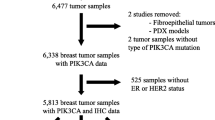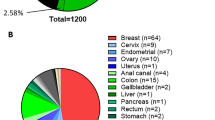Abstract
Mutations in the PIK3CA gene are common in breast cancer and represent a clinically useful therapeutic target. Several larger, population-based studies have shown a positive prognostic significance associated with these mutations. This study aims to further identify characteristics of patients harboring PIK3CA mutations while evaluating the clinical impact of genomic testing for these mutations. Tumors from 312 patients at Vanderbilt-Ingram Cancer Center were analyzed for PIK3CA mutations using a multiplex screening assay (SNaPshot). Mutation rates, receptor status, histopathologic characteristics, and time to recurrence were assessed. The number of patients participating in clinical trials, specifically trials relating to the PIK3CA mutation, was examined. Statistically significant differences between wild-type and mutated tumors were determined using the Wilcoxon, Pearson, and Fischer exact tests. The PIK3CA mutation was found in 25 % of tumors tested. Patients with PIK3CA mutations were significantly more likely to express hormone receptors, be of lower combined histological grade, and have a reduced time to recurrence. Patients found to have a PIK3CA mutation were significantly more likely to enter a PIK3CA-specific clinical trial. In addition to confirming previously established positive prognostic characteristics of tumors harboring PIK3CA mutations, this study demonstrates the feasibility and utility of mutation profiling in a clinical setting. PIK3CA mutation testing impacted treatment and resulted in more patients entering mutation-specific clinical trials.


Similar content being viewed by others
References
Dillon RL, White DE, Muller WJ (2007) The phosphatidyl inositol 3-kinase signaling network: implications for human breast cancer. Oncogene 26(9):1338–1345
Campbell IG et al (2004) Mutation of the PIK3CA gene in ovarian and breast cancer. Cancer Res 64(21):7678–7681
Li SY et al (2006) PIK3CA mutations in breast cancer are associated with poor outcome. Breast Cancer Res Treat 96(1):91–95
Kalinsky K et al (2009) PIK3CA mutation associates with improved outcome in breast cancer. Clin Cancer Res 15(16):5049–5059
Cizkova M et al (2012) PIK3CA mutation impact on survival in breast cancer patients and in ERalpha, PR and ERBB2-based subgroups. Breast Cancer Res 14(1):R28
Miller TW et al (2011) Mutations in the phosphatidylinositol 3-kinase pathway: role in tumor progression and therapeutic implications in breast cancer. Breast Cancer Res 13(6):224
Maruyama N et al (2007) Clinicopathologic analysis of breast cancers with PIK3CA mutations in Japanese women. Clin Cancer Res 13(2 Pt 1):408–414
Janku F et al (2012) PI3K/AKT/mTOR inhibitors in patients with breast and gynecologic malignancies harboring PIK3CA mutations. J Clin Oncol 30(8):777–782
Jensen DJ et al (2011) PIK3CA mutations may be discordant between primary and corresponding metastatic disease in breast cancer. Clin Cancer Res 17(4):667–677
Isakoff SJ et al (2005) Breast cancer-associated PIK3CA mutations are oncogenic in mammary epithelial cells. Cancer Res 65(23):10992–11000
Zhao L, Vogt PK (2008) Class I PI3K in oncogenic cellular transformation. Oncogene 27(41):5486–5496
Gonzalez-Angulo AM et al (2013) Frequency of mesenchymal-epithelial transition factor gene (MET) and the catalytic subunit of phosphoinositide-3-kinase (PIK3CA) copy number elevation and correlation with outcome in patients with early stage breast cancer. Cancer 119(1):7–15
Perez-Tenorio G et al (2007) PIK3CA mutations and PTEN loss correlate with similar prognostic factors and are not mutually exclusive in breast cancer. Clin Cancer Res 13(12):3577–3584
Loi S et al (2013) Somatic mutation profiling and associations with prognosis and trastuzumab benefit in early breast cancer. J Natl Cancer Inst 105(13):960–967
Saal LH et al (2005) PIK3CA mutations correlate with hormone receptors, node metastasis, and ERBB2, and are mutually exclusive with PTEN loss in human breast carcinoma. Cancer Res 65(7):2554–2559
Dumont AG, Dumont SN, Trent JC (2012) The favorable impact of PIK3CA mutations on survival: an analysis of 2587 patients with breast cancer. Chin J Cancer 31(7):327–334
Miller TW, Balko JM, Arteaga CL (2011) Phosphatidylinositol 3-kinase and antiestrogen resistance in breast cancer. J Clin Oncol 29(33):4452–4461
Campbell RA et al (2001) Phosphatidylinositol 3-kinase/AKT-mediated activation of estrogen receptor alpha: a new model for anti-estrogen resistance. J Biol Chem 276(13):9817–9824
Berns K et al (2007) A functional genetic approach identifies the PI3K pathway as a major determinant of trastuzumab resistance in breast cancer. Cancer Cell 12(4):395–402
Eichhorn PJ et al (2008) Phosphatidylinositol 3-kinase hyperactivation results in lapatinib resistance that is reversed by the mTOR/phosphatidylinositol 3-kinase inhibitor NVP-BEZ235. Cancer Res 68(22):9221–9230
Cizkova M et al (2013) Outcome impact of PIK3CA mutations in HER2-positive breast cancer patients treated with trastuzumab. Br J Cancer 108(9):1807–1809
Jensen JD et al (2012) PIK3CA mutations, PTEN, and pHER2 expression and impact on outcome in HER2-positive early-stage breast cancer patients treated with adjuvant chemotherapy and trastuzumab. Ann Oncol 23(8):2034–2042
Baselga, J., et al.,: Biomarker analyses in CLEOPATRA: a phase III, placebo-controlled study of pertuzumab in HER2-positive, first-line metastatic breast cancer (MBC). In: Thirty-fifth annual CTRC-AACR San Antonio Breast Cancer Symposium, San Antonio, TX, 4–8 Dec 2012; Cancer. Res. 72(24 Supplement), S5–1 (2012)
Baselga J, M.I., Nuciforo PG et al. (2013) PI3KCA mutations and correlation with pCR in the NeoALTTO trial (BIG 01-06). Presented at European Cancer Congress 2013; Sep 27–Oct 1,2013 ; Amsterdam. Abstract 1859, 2013
Janku F et al (2013) PIK3CA mutation H1047R is associated with response to PI3K/AKT/mTOR signaling pathway inhibitors in early-phase clinical trials. Cancer Res 73(1):276–284
Bendell JC et al (2012) Phase I, dose-escalation study of BKM120, an oral pan-Class I PI3K inhibitor, in patients with advanced solid tumors. J Clin Oncol 30(3):282–290
Hurst CD et al (2009) A SNaPshot assay for the rapid and simple detection of four common hotspot codon mutations in the PIK3CA gene. BMC Res Notes 2:66
Su Z et al (2011) A platform for rapid detection of multiple oncogenic mutations with relevance to targeted therapy in non-small-cell lung cancer. J Mol Diagn 13(1):74–84
Lovly CM et al (2012) Routine multiplex mutational profiling of melanomas enables enrollment in genotype-driven therapeutic trials. PLoS One 7(4):e35309
Hammond ME et al (2010) American Society of Clinical Oncology/College of American Pathologists guideline recommendations for immunohistochemical testing of estrogen and progesterone receptors in breast cancer (unabridged version). Arch Pathol Lab Med 134(7):e48–e72
Wolff AC et al (2007) American Society of Clinical Oncology/College of American Pathologists guideline recommendations for human epidermal growth factor receptor 2 testing in breast cancer. Arch Pathol Lab Med 131(1):18–43
Zhao L, Vogt PK (2008) Helical domain and kinase domain mutations in p110alpha of phosphatidylinositol 3-kinase induce gain of function by different mechanisms. Proc Natl Acad Sci U S A 105(7):2652–2657
Board RE et al (2008) Multiplexed assays for detection of mutations in PIK3CA. Clin Chem 54(4):757–760
Lurkin I et al (2010) Two multiplex assays that simultaneously identify 22 possible mutation sites in the KRAS, BRAF, NRAS and PIK3CA genes. PLoS One 5(1):e8802
Ramirez-Ardila DE et al (2013) Hotspot mutations in PIK3CA associate with first-line treatment outcome for aromatase inhibitors but not for tamoxifen. Breast Cancer Res Treat 139(1):39–49
Knight WA et al (1977) Estrogen receptor as an independent prognostic factor for early recurrence in breast cancer. Cancer Res 37(12):4669–4671
Kinne DW et al (1981) Estrogen receptor protein in breast cancer as a predictor of recurrence. Cancer 47(10):2364–2367
Acknowledgments
This study was supported by Grant UL1 TR000445 from NCATS/NIH. The support of Ms. Jamie Farley in consenting patients for this study is acknowledged.
Conflict of interest
The authors declare that they have no conflict of interest.
Ethical Standards
The experiments in this manuscript comply with the current laws of the United States.
Author information
Authors and Affiliations
Corresponding author
Rights and permissions
About this article
Cite this article
Abramson, V.G., Cooper Lloyd, M., Ballinger, T. et al. Characterization of breast cancers with PI3K mutations in an academic practice setting using SNaPshot profiling. Breast Cancer Res Treat 145, 389–399 (2014). https://doi.org/10.1007/s10549-014-2945-3
Received:
Accepted:
Published:
Issue Date:
DOI: https://doi.org/10.1007/s10549-014-2945-3




